PCB Cleanup Innovations: The Future of Removal Technology
- Last Updated: July 14th, 2025

Attorney Jessie Paluch, founder of TruLaw, has over 25 years of experience as a personal injury and mass tort attorney, and previously worked as an international tax attorney at Deloitte. Jessie collaborates with attorneys nationwide — enabling her to share reliable, up-to-date legal information with our readers.
Legally Reviewed
This article has been written and reviewed for legal accuracy and clarity by the team of writers and legal experts at TruLawsuit Info and is as accurate as possible. This content should not be taken as legal advice from an attorney. If you would like to learn more about our owner and experienced injury lawyer, Jessie Paluch, you can do so here.
Fact-Checked
TruLawsuit Info does everything possible to make sure the information in this article is up to date and accurate. If you need specific legal advice about your case, contact our team by using the chat on the bottom of this page. This article should not be taken as advice from an attorney.
Key Takeaways:
- The Environmental Protection Agency (EPA) has provided comprehensive guidelines and effective strategies for managing PCB wastes, offering valuable insights into proper waste disposal and handling practices.
- Ongoing cleanup programs are essential for restoring affected sites to safe conditions. These programs involve the careful removal of pollutants and contaminants, as well as the implementation of measures to prevent further environmental damage.
- Depending on the level of PCB contamination, different methods such as soil excavation, chemical treatment, or thermal desorption may be employed to remediate the site.
Overview of PCB Cleanup Technology
On this page, we’ll discuss an overview of PCB cleanup technology, waste management PCB cleanup options under the Toxic Substances Control Act, advanced strategies to eliminate occupational exposure to PCBs, and much more.
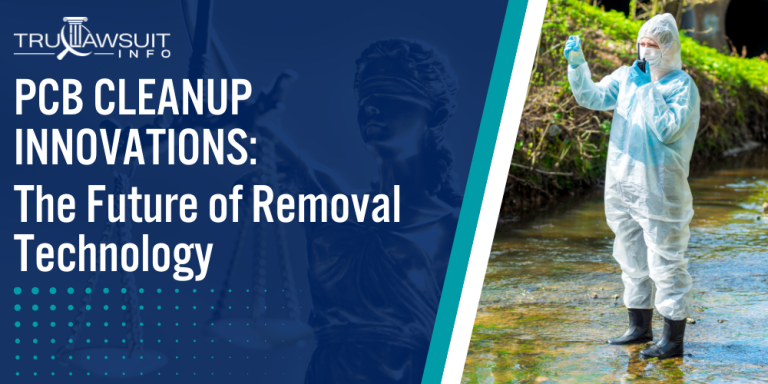
Intro to PCB Cleanup Technology
These advancements stem from a pressing need to tackle PCB remediation waste, which poses significant environmental and health risks.
Here are the key technologies employed in PCB cleanup:
- Chemical Dechlorination: A process that chemically breaks down PCBs in soil and transformer oil, rendering them non-toxic.
- Thermal Desorption: Heats the contaminated materials, causing the PCBs to vaporize and separate from the medium.
- High-Efficiency Air Filtration: Used particularly in indoor cleanup sites to capture airborne PCB particles.
- Bioremediation: Involves the use of microorganisms to degrade PCBs into less harmful compounds.
If you or a loved one has experienced adverse health conditions after being exposed to PCB chemicals, you may qualify to pursue compensation.
Contact TruLawsuit Info using the chat on this page to receive an instant case evaluation to determine if you qualify to file a PCB lawsuit today.
Table of Contents
Pioneering the Next Generation of PCB Remediation Techniques
As regulatory cleanup standards evolve and technology advances, the approaches to managing and mitigating the risks associated with Polychlorinated Biphenyls (PCBs) are becoming more sophisticated.
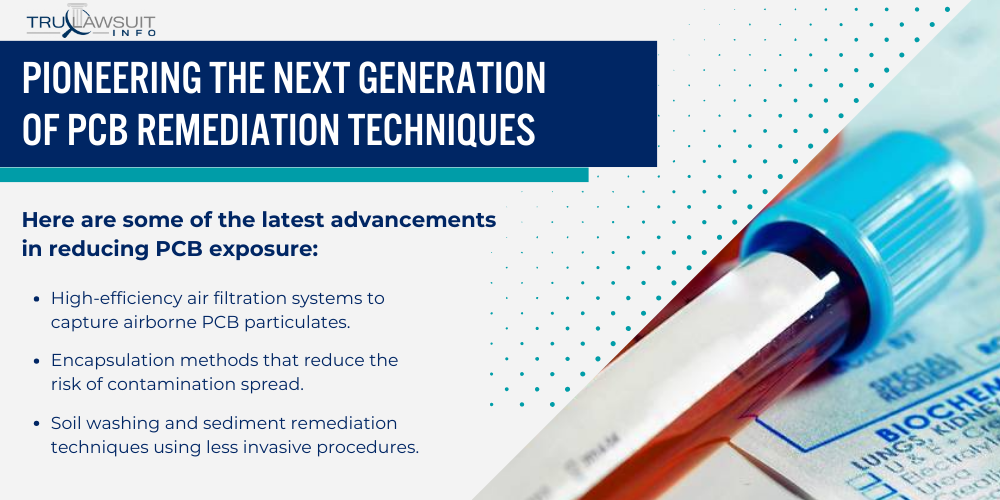
This section explores recent innovations in PCB remediation protocols, worker safety, and guidelines poised to redefine environmental restoration efforts.
Advancements in Safe Protocols for Reducing Exposure to PCBs
PCBs pose significant health and environmental risks, necessitating the development of safer remediation protocols.
EPA guidelines ensure that new techniques not only remove these compounds but also minimize human and environmental exposure.
Here are some of the latest advancements in reducing PCB exposure:
- High-efficiency air filtration systems to capture airborne PCB particulates.
- Encapsulation methods that reduce the risk of contamination spread.
- Soil washing and sediment remediation techniques using less invasive procedures.
- Innovative chemical extraction methods to isolate and remove PCBs from affected materials.
Innovative Measures to Protect Workers from PCB Exposure
Protecting workers during PCB cleanup projects is a top priority.
As technology advances, so do the measures to ensure the safety of those on the front lines.
The implementation of protective measures during remediation includes:
- Personal Protective Equipment (PPE) upgrades with advanced material technology for better resistance against PCBs.
- Enhanced decontamination stations for workers exiting contaminated zones.
- Real-time monitoring systems to detect PCB levels and alert workers.
- Improved training on handling and disposal of PCB-laden materials under performance-based cleanup protocols.
Developing Cutting-Edge Guidelines to Minimize Future PCB Risks
The creation of future-focused guidelines by entities like the EPA plays a significant role in mitigating risks associated with PCBs.
Such guidelines are designed to respond to novel contamination scenarios and incorporate current scientific understanding.
Newly formulated guidelines cover several innovative strategies:
- Enhanced EPA approval processes for emerging PCB remediation technologies.
- Information dissemination protocols to keep communities informed about ongoing remediation efforts.
- Risk assessment models that better predict long-term environmental impacts.
- Regulatory frameworks that encourage the adoption of sustainable and green remediation practices.
Revolutionizing Health and Safety in PCB-Contaminated Sites
The management of PCB-contaminated sites is undergoing significant change, with advanced risk assessment methods and safety protocols contributing to more effective and safer cleanup operations.
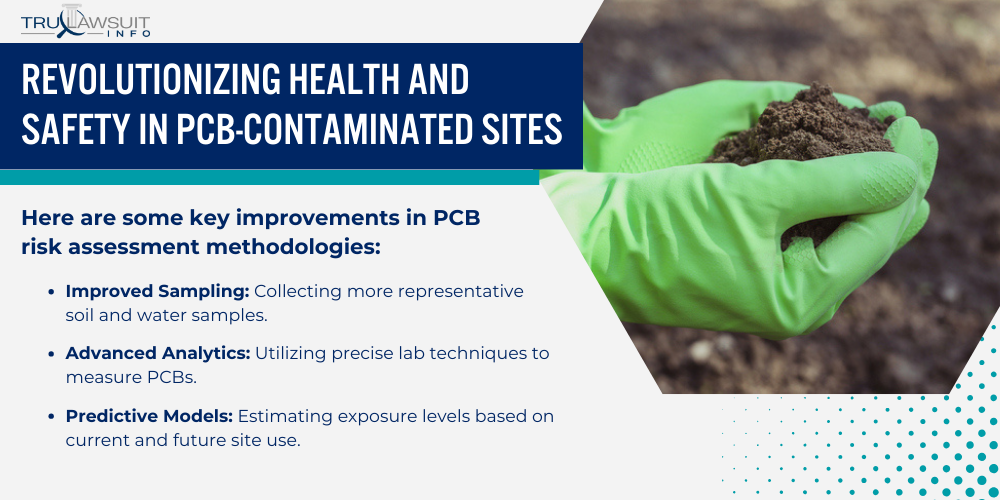
Elevating Risk Assessments to Predict PCB Exposure Better
Risk assessments have become more sophisticated, integrating detailed models to estimate PCB concentrations and exposure.
This approach leads to tailored safety measures at contaminated sites.
Here are some key improvements in PCB risk assessment methodologies:
- Improved Sampling: Collecting more representative soil and water samples.
- Advanced Analytics: Utilizing precise lab techniques to measure PCBs.
- Predictive Models: Estimating exposure levels based on current and future site use.
- Community Engagement: Incorporating public input into risk assessment processes.
Formulating Futuristic Cleanup Plans to Lessen PCB Exposure
Strategic cleanup plans place emphasis on reducing PCB exposure, aiming for cleanup levels that safeguard health while considering ecological sustainability.
Here are some key strategies for PCB cleanup:
- Removal Techniques: Employing state-of-the-art methods for extracting PCBs from the environment.
- On-site Treatments: Minimizing the movement of contaminants and reducing potential exposure.
- Long-term Monitoring: Vigilant observation to ensure the cleanup’s effectiveness and prevent recontamination.
- Innovative Technologies: Incorporating new technologies for cleaning up PCBs more efficiently and safely.
Setting New Standards for Worker Safety Certification in PCB Sites
Certification programs for workers at PCB sites now prioritize specialized training on PCB hazards and proper safety equipment usage.
To achieve this enhanced level of protection, several key areas are addressed in the new certifications:
- Specialized Training: Emphasizing the health risks associated with different PCB concentrations.
- Personal Protective Equipment (PPE): Ensuring the correct usage and maintenance.
- Emergency Protocols: Preparing workers for potential exposure incidents.
- Health Monitoring: Implementing regular check-ups for early detection of PCB-related health issues.
Revolutionizing health and safety protocols in PCB cleanup activities underscores the importance of staying ahead of potential risks, ensuring both the wellness of cleanup personnel and the long-term security of the surrounding communities.
Advanced Strategies to Eliminate Occupational Exposure to PCBs
Employing advanced strategies is essential to both mitigate risks and ensure the health and safety of those in environments potentially contaminated by Polychlorinated Biphenyls (PCBs).
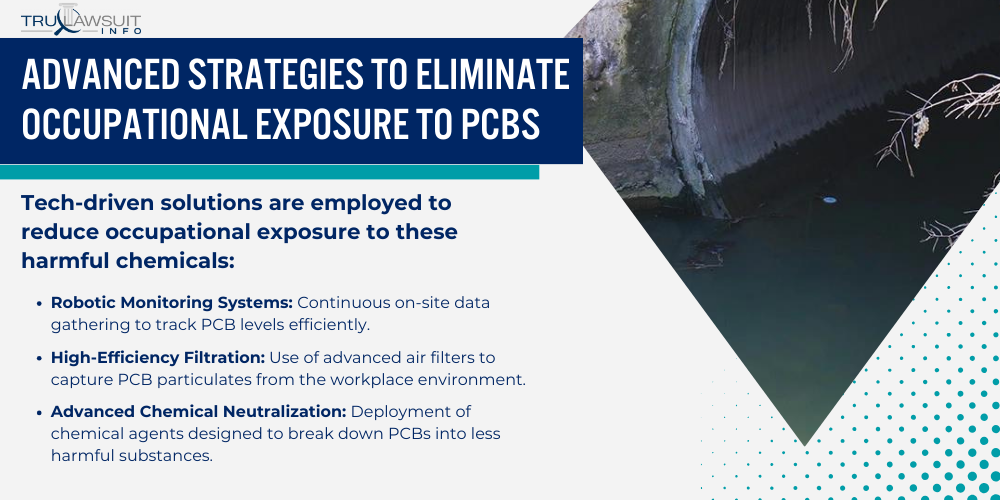
The focus on utilizing technology, tailoring self-implementing cleanup processes, and enhancing insurance coverage plays a significant role in successful decontamination efforts.
Implementing Tech-Driven Cleanup Solutions for PCB Decontamination
Technology plays a pivotal role in the decontamination of PCBs.
Tech-driven solutions are employed to reduce occupational exposure to these harmful chemicals:
- 1. Robotic Monitoring Systems: Continuous on-site data gathering to track PCB levels efficiently.
- 2. High-Efficiency Filtration: Use of advanced air filters to capture PCB particulates from the workplace environment.
- 3. Advanced Chemical Neutralization: Deployment of chemical agents designed to break down PCBs into less harmful substances.
- 4. Innovative Soil Washing Methods: Techniques using solvents or other cleaning agents to remove PCBs from contaminated soils at hazardous waste landfills.
Tailoring Performance and Risk-Based Cleanup to New PCB Technologies
The emergence of new PCB technologies demands a shift from standardized cleanup methods to a more nuanced approach.
This means developing strategies that consider the unique characteristics of each site and its PCB contamination.
Modern PCB cleanup and disposal activities are not one-size-fits-all but are instead tailored to specific contexts:
- 1. Adaptive Remediation Strategies: Develop site-specific plans that reflect the nature and concentration of PCBs present.
- 2. Performance-Based Cleanup Operations: On-going assessment and adjustment of cleanup methods according to real-time data.
- 3. Risk Assessment Tools: Utilize precise risk assessment models to prioritize and target cleanup operations.
- 4. Transparent Reporting Mechanisms: Ensuring clear documentation of cleanup progress and outcomes to stakeholders.
Enhancing Insurance Coverage Options for PCB Exposure with Innovation
Currently, managing the risks associated with PCB exposure presents a significant challenge.
By offering innovative insurance products specifically designed for PCB exposure, we can empower businesses and individuals to tackle these challenges with greater confidence and financial security.
Innovative insurance programs that provide coverage options for PCB exposure are crucial to risk management:
- 1. Specialized Coverage Plans: Insurance schemes tailored to the specific risks associated with PCB remediation work.
- 2. Collaborative Risk Sharing: Partnerships between businesses and insurers to share the burden of cleanup liabilities.
- 3. Coverage for Emerging Technologies: Insurance that specifically addresses the use of new technologies in risk-based cleanup.
- 4. Financial Assurance Products: Innovative financial products to secure funds necessary for comprehensive PCB remediation efforts.
Upgrading PCB Waste Management with Modern Technology
Upgrading the management of polychlorinated biphenyls (PCBs) is critical to environmental safety.
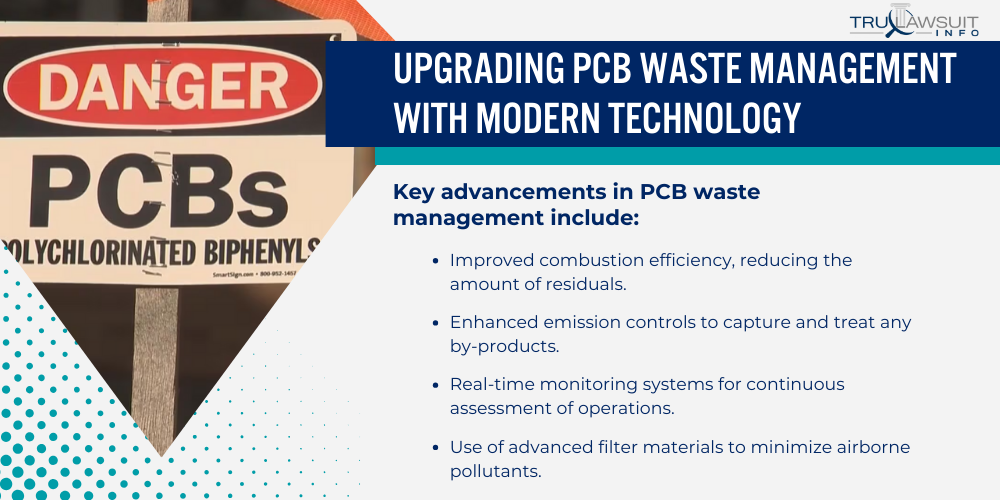
Utilizing modern technology can lead to more efficient and safer PCB remediation methods.
Advancing High-Temperature Incineration for Efficient PCB Removal
High-temperature incineration has proved to be an effective technology for the destruction of PCBs.
Key advancements include:
- Improved combustion efficiency, reducing the amount of residuals.
- Enhanced emission controls to capture and treat any by-products.
- Real-time monitoring systems for continuous assessment of operations.
- Use of advanced filter materials to minimize airborne pollutants.
These improvements are essential for ensuring that PCB incineration is both thorough and environmentally sound.
Exploring Alternative PCB Disposal Techniques with Lower Exposure Risks
Researchers are exploring alternative disposal methods that can potentially mitigate the risks associated with PCB management.
Emerging techniques include:
- Base-catalyzed decomposition, which neutralizes PCBs without high temperatures.
- Electric arc methods that break down PCB molecules with high-energy plasma.
- Biological treatments using specialized microorganisms.
- Chemical dechlorination, which chemically breaks down PCBs safely at lower temperatures.
Each exhibits the potential for lowering exposure risks during the disposal process.
Innovating in Chemical Landfill Practices for Safer PCB Handling
Enhancements in chemical waste landfill practices have significantly improved the safety of PCB handling.
Modern hazardous waste landfill technologies focus on:
- Improving liner systems to prevent leachate escape.
- Advanced capping methods that seal off waste from the atmosphere.
- The integration of leachate collection systems for proper treatment.
- Implementing comprehensive groundwater monitoring and disposal program.
These innovations contribute to a safer environmental containment of PCB waste.
Facilitating Technologically Enhanced PCB Disposal Approval Processes
Technology has streamlined the approval process for PCB disposal.
Technological enhancements include:
- Online platforms for simplified submission of disposal applications.
- Digital tracking systems are used to monitor such disposal site compliance.
- Utilization of Geographic Information Systems (GIS) for site selection.
- Accelerated risk assessment tools for faster decision-making.
Such advancements in technology ensure that PCB disposal approval processes are more effective and less time-consuming.
Streamlining PCB Cleanup Approvals with Technology
Technological advancements are revolutionizing the way the Environmental Protection Agency (EPA) handles PCB cleanup approvals, expediting processes, and improving efficiency in dealing with bulk PCB remediation waste.
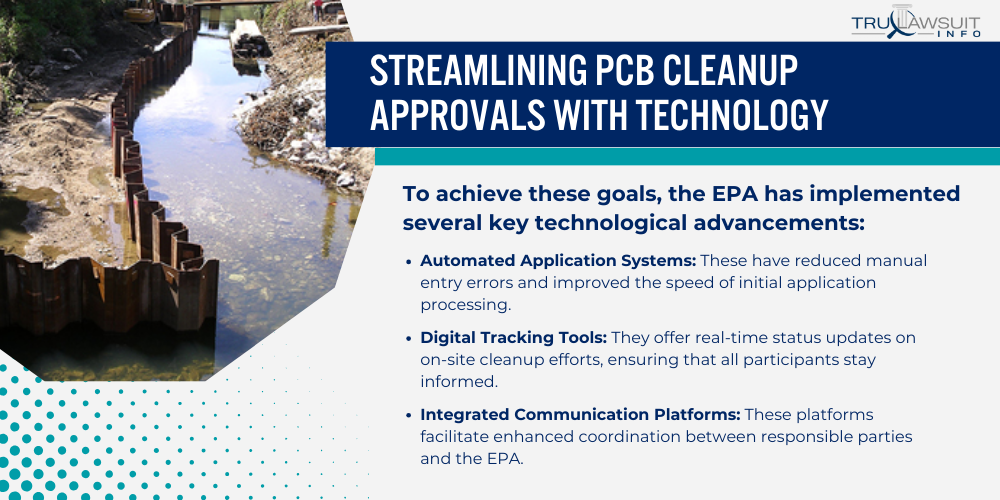
Redefining Cleanup Application Processes to Prevent PCB Exposure
The EPA has made significant strides in redeveloping the application workflows associated with PCB cleanups.
This effort focuses on preventing potential PCB exposure and streamlining the approval procedure.
To achieve these goals, the EPA has implemented several key technological advancements:
- Automated Application Systems: These have reduced manual entry errors and improved the speed of initial application processing.
- Digital Tracking Tools: They offer real-time status updates on on-site cleanup efforts, ensuring that all participants stay informed.
- Integrated Communication Platforms: These platforms facilitate enhanced coordination between responsible parties and the EPA.
- Online Submission Portals: Centralized portals make it simpler for parties to submit cleanup completion notifications and other required documentation.
Leveraging these technological improvements enables a more responsive and transparent framework for managing and mitigating the risks associated with PCBs.
Leveraging Tech to Influence EPA Decisions on PCB Remediation
The use of innovative technology plays a pivotal role in influencing EPA decisions regarding the management and disposal facility of PCBs.
Below are key tech-driven interventions playing a role in PCB remediation:
- Data Analytics: Utilizing advanced analytics to evaluate bulk PCB remediation waste and support decision-making processes.
- GIS Mapping: Geographic Information Systems aid in the accurate mapping and risk assessment of contaminated sites.
- Mobile Reporting Applications: These apps streamline the submission of data and cleanup completion notifications to the EPA.
- AI Modeling: Artificial intelligence helps predict outcomes and optimize cleanup methods, leading to more informed EPA approvals.
The integration of these technologies into the regulatory processes fosters a more efficient approval system, which, ultimately, hastens the remediation of PCB-contaminated sites.
For a detailed understanding of the framework used by the EPA to expedite PCB site cleanup approvals, you can review the PCB Facility Approval Streamlining Toolbox (FAST).
This toolbox is a practical example of how technological tools are employed to facilitate EPA engagement with responsible parties.
Technological Preparedness for PCB Incidents in the Workplace
The development of robust technological frameworks is integral to mitigating and managing Polychlorinated Biphenyl (PCB) incidents in the workplace.
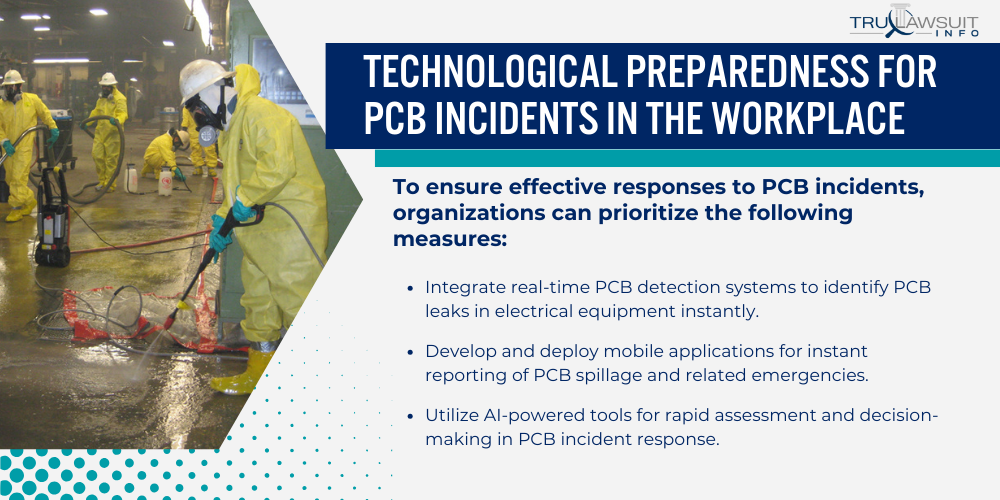
Addressing PCB waste involves a careful balance of resource conservation, safe handling of PCB-containing equipment, and compliance with regulatory measures.
Crafting Futuristic PCB Waste Management Strategies for Emergencies
Technological innovation is at the heart of advancing PCB waste management in emergency situations.
To ensure effective responses to PCB incidents, organizations can prioritize the following measures:
- Integrate real-time PCB detection systems to identify PCB leaks in electrical equipment instantly.
- Develop and deploy mobile applications for instant reporting of PCB spillage and related emergencies.
- Utilize AI-powered tools for rapid assessment and decision-making in PCB incident response.
- Implement specialized software to track and optimize the use of resources during decontamination.
Leveraging these technologies in the workplace strengthens the capability to respond to PCB emergencies swiftly and effectively.
Adopting New Regulatory Frameworks for Safe PCB-Equipment Handling
The landscape of PCB regulations is constantly evolving.
Adhering to these updated frameworks is crucial to ensure workplaces remain compliant and prioritize safety in handling PCB-containing equipment.
To foster safety and compliance in the handling of PCB-containing equipment, workplaces must adhere to updated regulatory frameworks:
- Establish comprehensive training programs concerning the latest PCB regulations and safe handling practices.
- Utilize digital systems to streamline the documentation and reporting of PCB-related incidents.
- Adopt safety protocols for preventive maintenance and inspection of PCB-containing machinery.
- Implement hazard communication systems to keep personnel informed and alert to PCB risks.
Understanding and embracing the relevant regulations, such as the PCB remediation waste guidelines and the Policy and Guidance for Polychlorinated Biphenyl, is essential for safely handling PCB equipment and effectively managing potential incidents.
Reinforcing Worker Protections with Innovations Against PCB Exposure
As industries continue to manage the risks associated with polychlorinated biphenyls (PCBs), innovations in worker safety protocols and legal frameworks play pivotal roles.
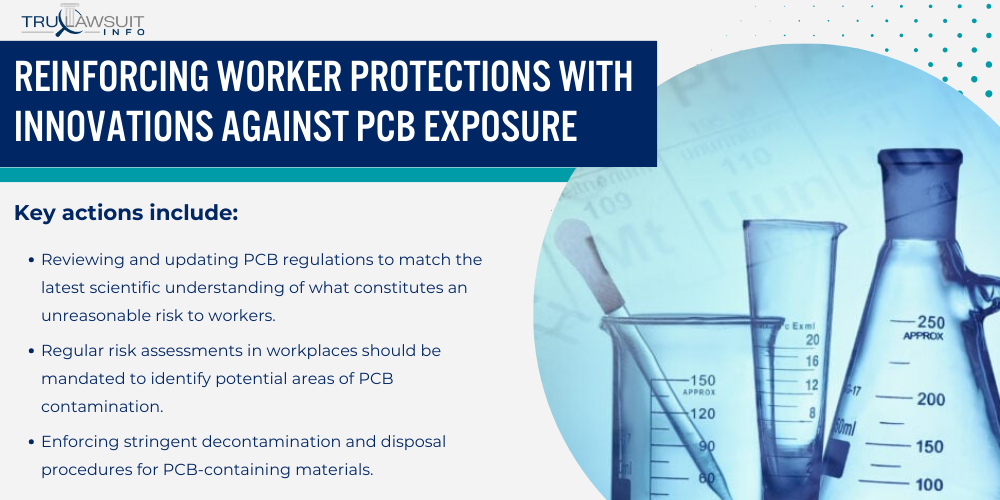
This section explores the strengthening of legal measures and the advocacy for advanced protection rights to shield workers from PCB exposure risks.
Strengthening Legal Measures to Combat Workplace PCB Exposure Risks
Legal regulations serve as the backbone for maintaining worker safety in environments where PCBs are present.
Ensuring compliance with existing laws is a dynamic process that involves regular updates and enforcement actions.
Key actions include:
- Reviewing and updating PCB regulations to match the latest scientific understanding of what constitutes an unreasonable risk to workers.
- Regular risk assessments in workplaces should be mandated to identify potential areas of PCB contamination.
- Enforcing stringent decontamination and disposal procedures for PCB-containing materials.
- Providing comprehensive training for workers on how to handle PCBs safely and recognize signs of excessive human exposure.
Continuous improvement in legal standards communicates a firm commitment to protecting workers’ health and well-being.
Reinforcement of regulatory compliance is crucial; it ensures that safety measures keep pace with workplace hazards’ evolving nature.
Advocating for Advanced Protective Rights for Workers Facing PCB Dangers
Worker advocacy groups play a fundamental role in pushing for more comprehensive protections for individuals exposed to PCBs in the workplace.
Efforts to enhance protection include:
- Campaigning for clearer labeling and cleanup completion notification systems that alert workers to the presence of PCBs.
- Requesting businesses to provide state-of-the-art personal protective equipment (PPE), particularly in high-risk areas.
- More frequent medical monitoring is needed to detect and address PCB-related health issues quickly.
- Ensuring that worker protection laws are inclusive of the latest PCB cleanup technologies and safety procedures.
These focused measures are designed to reduce the risk of PCB exposure and enforce the notion that worker health is non-negotiable.
As the industry advances, so must the protections afforded to those who work within it.
Shaping a Safer Future Through Technological Advancements in PCB Cleanup
Technological advancements are instrumental in enhancing worker safety and reducing PCB exposure to ensure compliance with cleanup and disposal obligations.
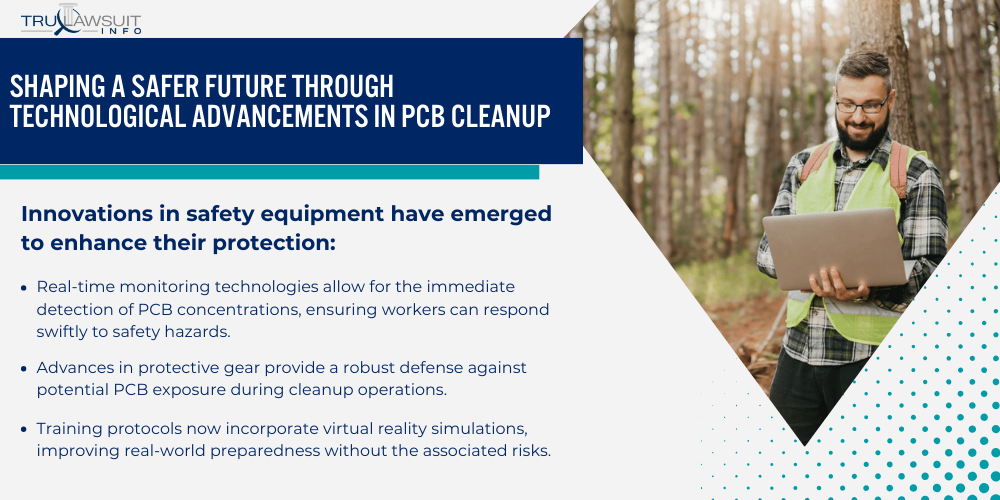
These innovations also promise to safeguard human health more effectively.
Monitoring Innovative PCB Management Tactics for Enhanced Worker Safety
Workers managing PCB cleanup are on the front lines of safeguarding environmental and public health.
Innovations in safety equipment have emerged to enhance their protection:
- Real-time monitoring technologies allow for the immediate detection of PCB concentrations, ensuring workers can respond swiftly to safety hazards.
- Advances in protective gear provide a robust defense against potential PCB exposure during cleanup operations.
- Training protocols now incorporate virtual reality simulations, improving real-world preparedness without the associated risks.
- Enhanced decontamination facilities support swift and thorough cleansing after potential exposure.
These tactics, informed by the emergence of new science, aim to minimize risk and promote a culture of safety.
Championing Comprehensive Cleanup Technologies to Eradicate PCB Exposure
Complete eradication of PCBs from contaminated sites is crucial for a healthier future.
Integration of advanced technologies assists in this mission:
- Thermal desorption equipment removes PCBs from soil with high efficacy, thereby limiting lingering environmental risks.
- The development of advanced analytical methods provides a more accurate assessment of PCB contamination levels.
- Chemical extraction techniques have become more sophisticated, offering greater extraction efficiencies.
- The use of bioremediation strategies, such as certain bacteria, break down PCBs into less harmful compounds.
These technologies support the regulated community in adhering to stringent environmental guidelines and protecting public health.
Embracing Eco-Friendly Cleanup Innovations for Sustainable Worker Environments
Traditional cleanup methods often come with a hidden cost – environmental damage.
By prioritizing eco-friendly options, we can safeguard worker health while protecting the surrounding ecosystems for the future.
Environmentally responsible cleanup options are becoming a priority to lessen the impact of remediation on ecosystems:
- Phytoremediation, the use of plants in absorbing or breaking down pollutants, is an emerging area that harnesses natural processes.
- Innovations in green chemistry aim to decontaminate sites without introducing further hazards.
- Eco-friendly solvents are replacing more toxic alternatives for PCB extraction.
- Enhanced waste management tactics ensure that materials are disposed of in a manner that respects environmental integrity.
This focus on sustainability in the face of PCB remediation reflects a commitment to the long-term welfare of both workers and the community at large.
Frequently Asked Questions
-
What is the recommended procedure for PCB spill cleanup?
For PCB spill cleanup, the Environmental Protection Agency (EPA) recommends that the affected area be contained quickly to prevent the spread of contamination.
The cleanup should follow the guidelines which focus on prompt decontamination employing methods such as adsorption, chemical dechlorination, and thermal destruction.
-
How does the EPA regulate the cleanup of PCB contamination?
The EPA regulates PCB cleanup through the Toxic Substances Control Act (TSCA), which incorporates a specific set of rules found in 40 CFR part 761.
These regulations mandate a range of responses depending on the PCB concentration, ensuring that environmental and human health risks are minimized.
-
What is the definition of PCB remediation waste?
PCB remediation waste comprises materials contaminated with PCBs as a result of a leak or spill.
The Environmental Protection Agency categorizes it according to its origin, such as contaminated soil, sediments, or building materials like caulk and paint, providing guidance on appropriate handling and disposal.
-
Which policies govern the cleanup of PCB spills?
The EPA’s PCB Spill Cleanup Policy provides direction for containment and remediation practices according to the age of the spill and other considerations.
The policies governing the cleaning up of PCB spills are outlined in the Code of Federal Regulations, particularly under 40 CFR part 761, Subpart G.
-
In what ways can PCBs be effectively removed from the environment?
Several methods can effectively remove PCBs from the environment, including incineration at high temperatures designed to destroy the compounds, chemical dechlorination, which transforms PCBs into less harmful chemicals, and encapsulation, which immobilizes PCBs to prevent leaching.
-
What are the approved methods for disposing of PCBs?
As outlined by the EPA, approved PCB disposal methods entail high-temperature incineration, approved chemical waste landfills, and non-thermal destruction methods.
These methods are selected based on the concentration of PCBs and comply with federal regulations to prevent environmental contamination.

Experienced Attorney & Legal SaaS CEO
With over 25 years of legal experience, Jessie is an Illinois lawyer, a CPA, and a mother of three. She spent the first decade of her career working as an international tax attorney at Deloitte.
In 2009, Jessie co-founded her own law firm with her husband – which has scaled to over 30 employees since its conception.
In 2016, Jessie founded TruLaw, which allows her to collaborate with attorneys and legal experts across the United States on a daily basis. This hypervaluable network of experts is what enables her to share reliable legal information with her readers!
Have A Case?
Here, at Tru Lawsuit Info, we’re committed to helping victims get the justice they deserve.
To do this, we actively work to connect them with attorneys who are experts in litigating cases similar to theirs.
Would you like our help?
Tru Lawsuit Info is a reliable source of information about issues that may affect your health and safety, such as faulty products, data breaches, and environmental hazards.
Our team of experienced writers collaborates with medical professionals, lawyers, and advocates to produce informative articles, guides, and other resources that raise awareness of these topics.
Our thorough research provides consumers with access to reliable information and updates on lawsuits happening around the country. We also can connect consumers with attorneys if they need assistance.
Camp Lejeune's water contamination issue spanned several decades starting in the 1950s. Exposure to these chemicals has been linked to various serious health issues, including cancer, organ diseases, and death.
Research is increasingly suggesting a link between the use of Tylenol during pregnancy and the development of neurodevelopmental disorders, such as autism and ADHD, in infants.
Legal action is being taken against manufacturers of Aqueous Film-Forming Foam (AFFF), a chemical used in fighting fires. The plaintiffs allege that exposure to the foam caused health issues such as cancer, organ damage, and birth and fertility issues.
Have A Case?
Here, at Tru Lawsuit Info, we’re committed to helping victims get the justice they deserve.
To do this, we actively work to connect them with attorneys who are experts in litigating cases similar to theirs.
Would you like our help?







